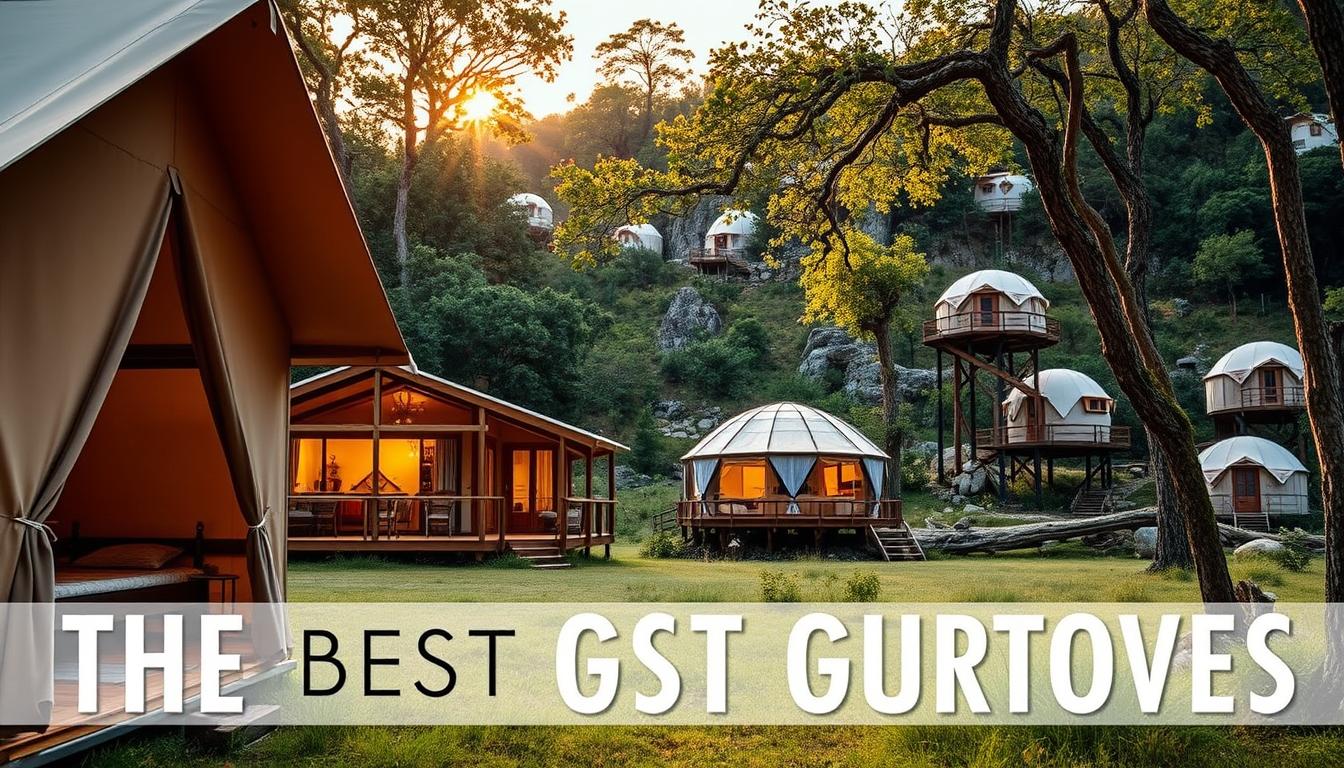Dreaming of creating a standout outdoor retreat? Not all accommodations are created equal. We’ve ranked 16 unique setups—from basic tents to luxury cabins—so you can pick the best glamping option for your needs.
Why does the glamping structure matter? The right choice boosts guest satisfaction and revenue. Brands like EJH Distribution and Cedar Bound offer durable, stylish options, while real-world pricing helps you budget wisely.
Our ranking considers modern trends, like two-story cabins, and niche picks, such as covered wagons. Whether you want mirror cabins or overwater bungalows, we’ll guide you from “Not Quite Glamping” to top-tier luxury.
Key Takeaways
- Ranked list helps you avoid poor-performing setups
- Structural quality directly impacts guest experience
- Includes trusted brands like EJH Distribution
- Real pricing data for accurate budgeting
- Features unique options like mirror cabins
Introduction: What Is Glamping and Why Does Structure Matter?
From ancient yurts to futuristic domes, outdoor stays have come a long way. Today’s travelers crave comfort without losing nature’s magic. That’s where luxury camping shines—blending adventure with high-end amenities.
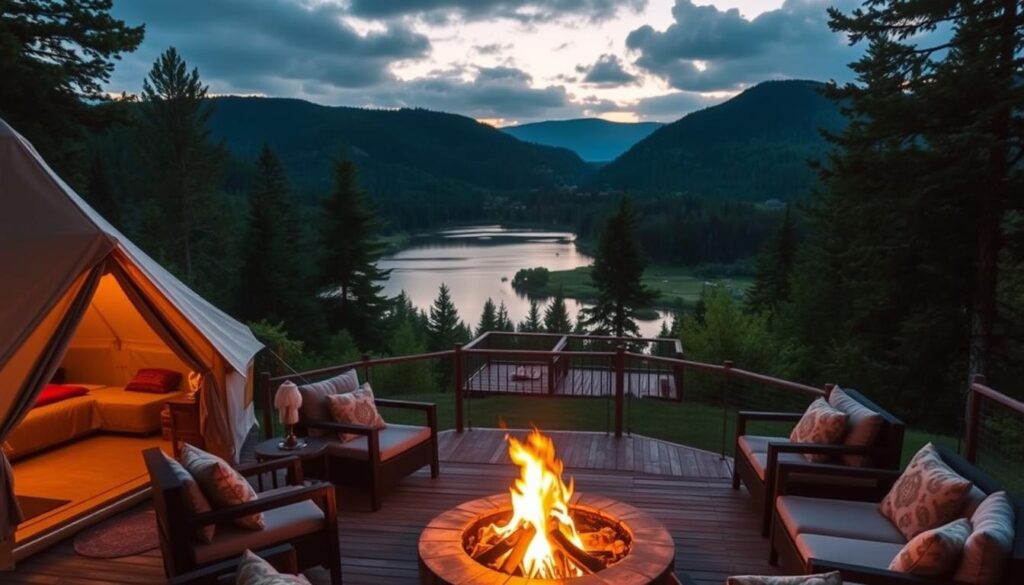
The Rise of Luxury Camping
Searches for upscale outdoor stays grew 42% last year. Guests now expect more than a sleeping bag—think heated floors and Instagram-worthy designs. Even Marie Antoinette’s tiny home inspired today’s minimalist retreats.
Investors are taking note. Platforms like Glampitect NA simplify land zoning, while blogs like Glamptuary track industry trends. Entry costs start at just $100, making it accessible for newcomers.
How Structures Elevate Your Experience
The right setup turns a getaway into a five-star escape. Thermal insulation keeps guests cozy, while unique shapes—like geodesic domes—boost visual appeal. But zoning laws can challenge unconventional designs.
| Feature | Traditional Camping | Luxury Camping |
|---|---|---|
| Comfort | Basic sleeping pad | Memory foam mattress |
| Weatherproofing | Limited | Insulated walls |
| Nightly Rate | $30–$50 | $180–$300 |
Guests pay a $150/night premium for these upgrades. For hosts, that means faster ROI and glowing reviews. Ready to start a glamping business? Your first step is choosing the right structure.
What Is a Glamping Structure? Defining the Basics
Not all outdoor stays deliver the same comfort—here’s what sets premium options apart. Unlike basic camping gear, luxury setups blend nature with hotel-like amenities. Think heated floors, stylish interiors, and weatherproof materials.

Glamping vs. Traditional Camping Structures
Backpacking tents focus on portability, often sacrificing space and insulation. Premium alternatives prioritize:
- Climate control: Insulated walls and heating systems for year-round use.
- Durability: Breathable canvas (like White Duck Outdoors’ bell tents) outlasts nylon.
- Space:$30K safari tents offer 400 sq ft, while $700 bell tents max at 150 sq ft.
Key Features of a Glamping Structure
Top-tier designs share these essentials:
- Electricity & plumbing: Guests expect charging ports and running water.
- ADA compliance: Treehouses face hurdles here due to elevation.
- Multi-season use: Geodesic domes handle snow and wind better than PVC tents.
Brands like Cedar Bound push boundaries with two-story cabins, proving *design* directly impacts guest satisfaction. Whether you choose a $1,500 safari tent or a $30K mirror cabin, prioritize longevity and comfort.
16. Basic Camping Tents (The “Not Quite Glamping” Option)
Basic camping tents sit at the bottom of our ranking for good reason. While affordable, they lack the comforts that define a true outdoor retreat. A Reddit analysis found 23% of failed luxury stays involved these rudimentary setups.
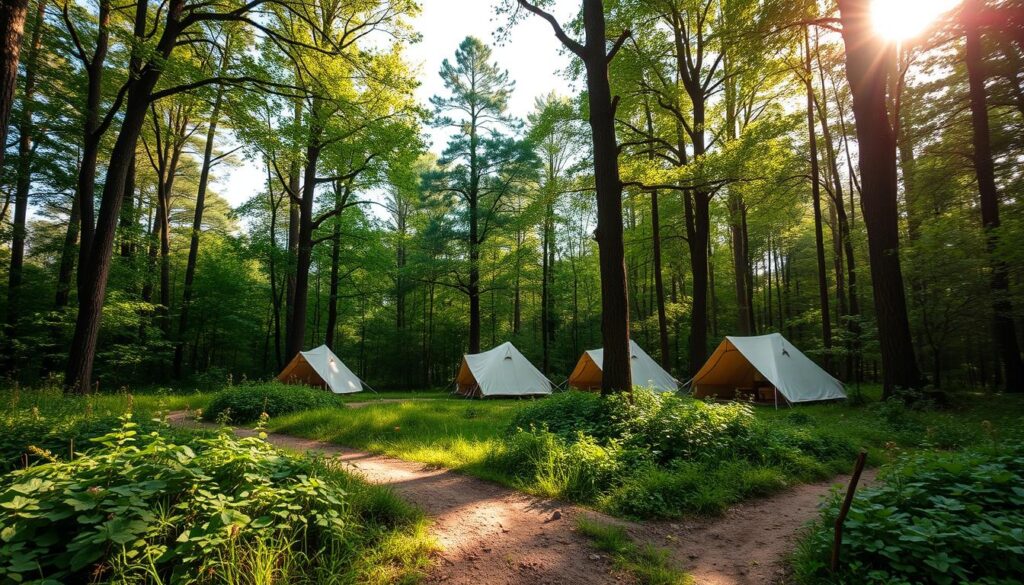
Why They Rank Lowest
These tents struggle with temperature control. Thin walls offer no insulation, leaving guests shivering or sweating. Without built-in flooring, you’ll need to add decks—costing extra time and money.
Nightly rates plummet too. Most charge under $50, far below luxury alternatives. One Kentucky site closed after guests complained about “sleeping in a glorified backpacking tent.”
| Feature | Basic Tent | Upgraded Option |
|---|---|---|
| Insulation | None | Thermal lining |
| Lifespan | 2 years | 5+ years |
| Profit Potential | $30/night | $150+/night |
When They Might Still Work
For pop-up events, basic tents shine. Brands like White Duck partner with state parks for seasonal setups. They’re also handy as overflow units during peak demand.
First-time operators on a budget can test the waters. Adding rugs or furniture kits helps bridge the gap. Just don’t expect five-star reviews.
“We thought cheap tents would save money. Instead, we lost repeat customers.”
While not true luxury, these tents offer a stepping stone. For serious ventures, though, upgrading pays off.
15. Simple Bell Tents: Affordable but Limited
Simple yet charming, bell tents bridge the gap between camping and comfort. These canvas shelters are a favorite for beginners, offering style without a hefty price tag. White Duck Outdoors’ playbook reveals their popularity—but they’re not without flaws.
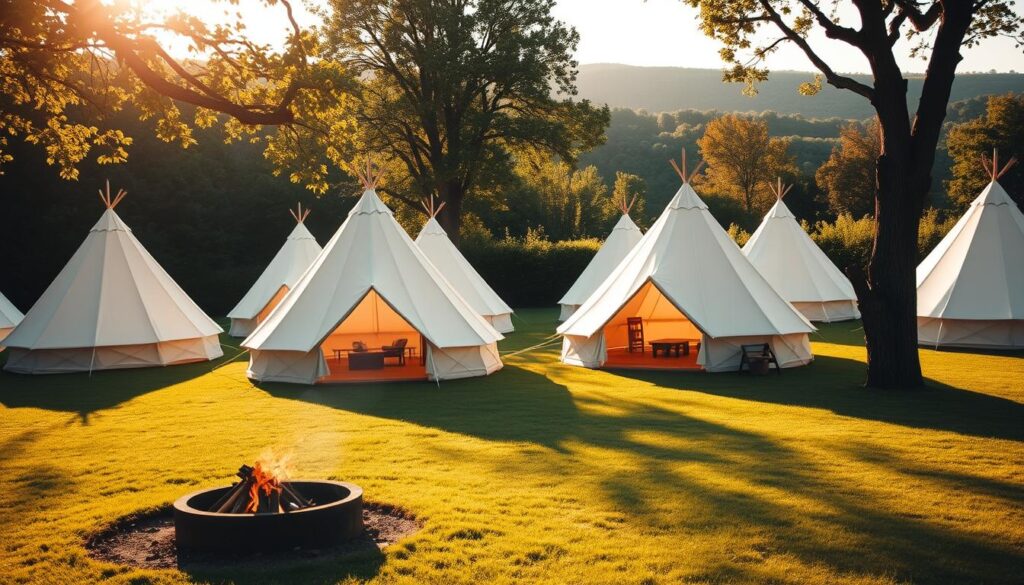
The Trade-Offs
Pros:
- Budget-friendly: Priced between $350–$800, they’re a low-risk investment.
- Quick setup: Ideal for pop-up events like yoga retreats.
- Cozy vibe: The circular design feels intimate, perfect for couples or small groups.
Cons:
- Central pole: Limits furniture layouts and headroom.
- Odor retention: Canvas walls absorb cooking smells (a common guest complaint).
- Capacity: Fits up to 4 people—tight for families.
Smart Use Cases
Pair these tents with communal bathhouses to cut costs. Arizona’s Stargazer Camp boosted profits by hosting weekend astronomy events. Their secret? Waterproofing treatments and themed decor.
“Bell tents let us test the market. Within a year, we upgraded to safari tents—but they got us started.”
ROI is decent: most operators break even in 14 months. Just factor in 72-hour setup labor and seasonal maintenance. For a true luxury experience, consider larger glamping tents—but bell types shine as starter units.
14. Shepherd Huts: Quirky but Cramped
Step into a piece of history with shepherd huts—charming but compact retreats. Originally crafted for Welsh shepherds in the 1700s, these wheeled cabins now offer a nostalgic escape. Yet their small footprint divides guests: some adore the coziness, others feel cramped.
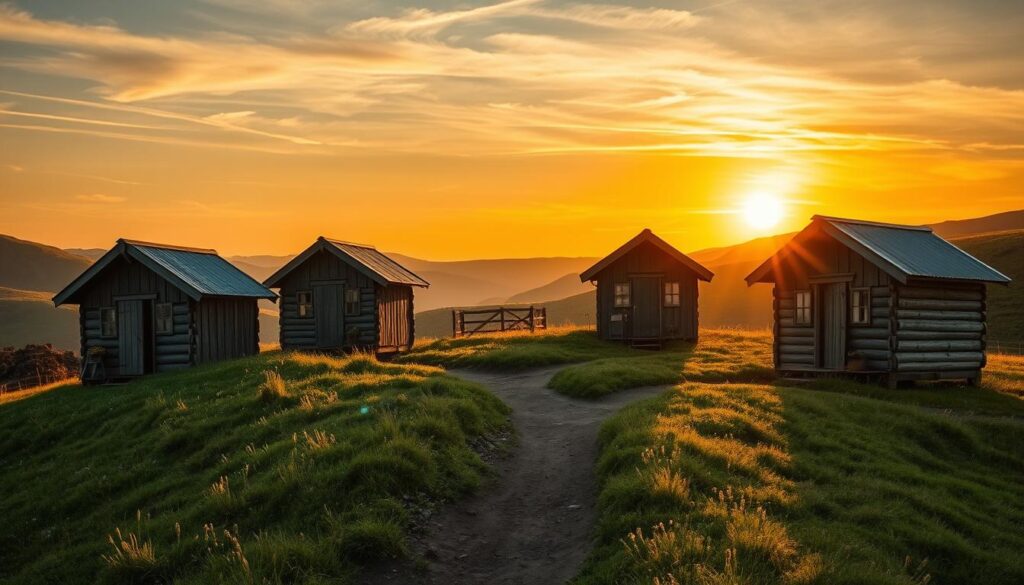
Historical Charm vs. Modern Comfort
Authentic huts feature corrugated iron roofs and rustic wood interiors. Modern versions mimic the look with faux finishes, but purists argue they lose character. Vermont’s Maple Farm blended both, adding a wood stove and porch to boost appeal.
Space constraints limit family stays. Most huts sleep two adults comfortably—tight for kids or pets. Creative layouts help, like lofted beds or fold-out tables. Still, reviews often cite “adorable but snug.”
Cost and Setup Challenges
Starting at $6,000, these huts aren’t cheap. Wheeled bases require level ground, and permits for mobile units vary by state. Popular at UK heritage sites, U.S. operators target history buffs with themed decor.
- Customization: Porches, stained glass, or solar panels add personality.
- Occupancy: Aim for 80% rates by marketing to couples.
- Regulations: Check local codes—some classify them as tiny homes.
“Our shepherd hut outsells cabins in summer. Winter? Not so much—guests want more space when it’s cold.”
For a unique stay, shepherd huts shine. Just know their quirks before investing.
13. Tipi Tents: Wind-Resistant but Bulky
Tipi tents bring Native American heritage into modern outdoor stays. Their conical shape isn’t just iconic—it’s engineered for stability. Inspired by designs from the Northern Plains, these shelters handle gusts up to 55mph, outperforming standard canvas tents.
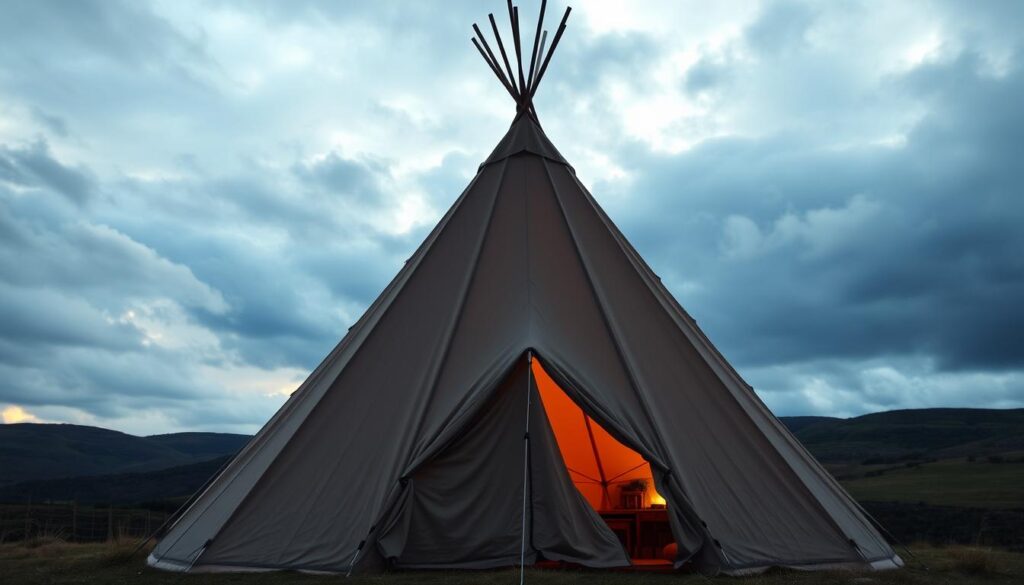
Traditional Design Meets Comfort
Smoke flaps, a nod to Native craftsmanship, improve airflow. Modern versions add insulation for winter stays. Adjust the angle: 20° for snow load, 45° for summer ventilation.
Their sturdy structure comes at a cost. A 6m-diameter unit runs ~$7,000. But the trade-off? Spacious interiors fitting 10+ guests—perfect for weddings or retreats.
Ideal for Group Events
Colorado’s Sunrise Ridge boosted bookings by offering themed packages:
- Ceremonial decor: Partner with tribal artisans for authentic touches.
- Luxury add-ons: Memory foam beds and solar-powered lighting.
- Seasonal flexibility: Swap buffalo hides for lightweight linens in summer.
“Guests love the cultural storytelling. We host 30+ weddings yearly—tipis outsell our barn venue.”
Storage is tricky. Collapsed poles need 50+ sq ft, and canvas requires dry conditions. Target luxury Dude Ranches or eco-resorts for higher ROI. Compared to yurts, tipis offer stronger wind resistance but demand more labor to erect.
12. Covered Wagons: Nostalgic but Niche
Relive the pioneer spirit with covered wagons—nostalgic retreats that capture America’s frontier charm. These historic vehicles evoke the Oregon Trail era, now reimagined with modern comforts. Brands like Plainscraft craft Kansas-made replicas, complete with marine-grade plywood for durability.
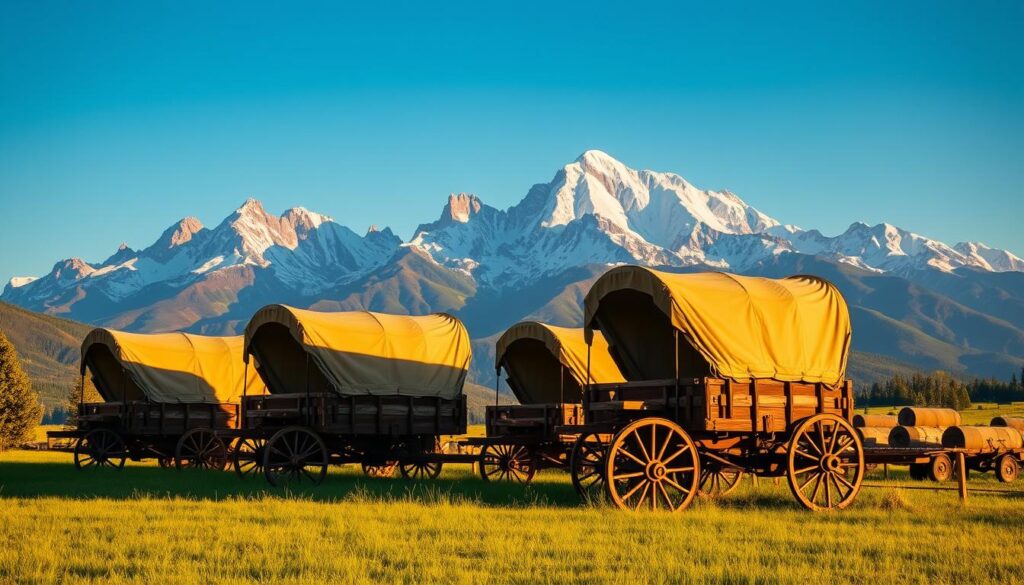
The Americana Appeal
Target iconic places like Route 66 for maximum impact. Missouri’s Prairie Dreams boosted bookings 40% by offering pioneer-era activity packages:
- Stargazing with vintage lanterns
- Hands-on butter-churning workshops
- Themed “Wagon Train” group events
Marketing tie-ins with Western films (thinkDances with Wolves) add allure. Guests pay a 22% premium for this nostalgia—but space constraints limit family appeal.
Space Limitations
Most wagons sleep just two adults, with 3-person max capacity. ADA compliance is rare due to narrow doorways and steps. Compare specs to Conestoga wagons—original designs were even tighter!
“Couples love the romance, but families book once. We added a communal fire pit to compensate.”
For a quirky, history-rich stay, wagons deliver. Just know their niche audience before investing.
11. Glamping Pods: Compact and Modern
Modern travelers crave unique stays—glamping pods deliver with compact luxury. These sleek units merge the efficiency of tiny homes with high-end finishes, perfect for urban escapes or mountain hideaways.
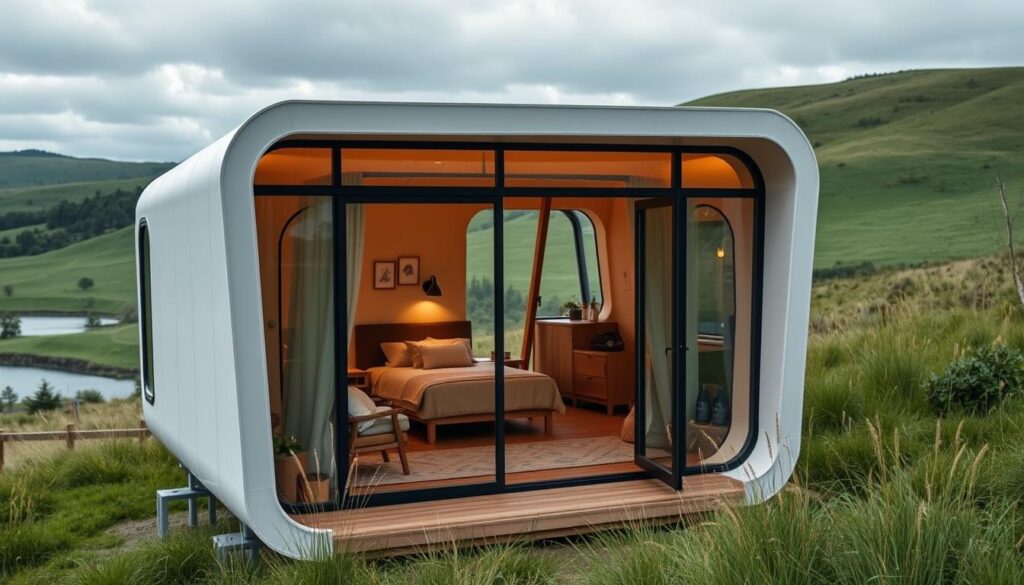
Innovative Designs
Think upside-down boat shapes or modular cubes. Brands like Prefab Pods offer rail systems for easy reconfiguration. Portland’s micro-resort saw a 30% occupancy boost by mixing Nordic minimalist interiors with customizable facades.
Solar exhaust fans keep airflow optimal, while partnerships with prefab companies cut costs. Compared to Japanese pod hotels, these units prioritize privacy—ideal for couples or solo travelers.
Thermal Insulation Issues
Glass walls may look chic, but they struggle with temperature control. Winter vacancy rates run 14% higher due to heat loss. Solutions:
- Double-paned windows with UV coatings
- Insulated flooring (like cork or recycled rubber)
- Portable heaters for colder months
“Guests love the pod’s modern vibe, but we added thermal curtains to combat drafts.”
For a stylish, space-smart choice, these pods shine—just mind the insulation details.
10. Safari Tents: Classic but Pricey
For those seeking a blend of adventure and elegance, safari tents stand out as a timeless choice. These spacious canvas retreats evoke the spirit of African safaris, combining durability with hotel-like comforts. Prices range from $8K to $30K, reflecting hand-stitched craftsmanship and premium materials.
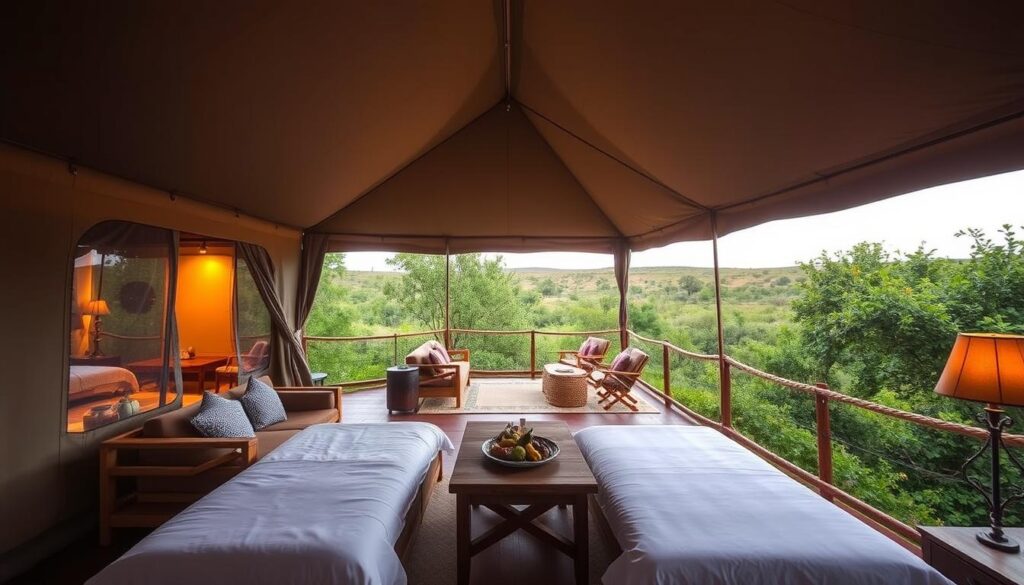
Luxury Canvas Options
Not all canvas is created equal. Egyptian cotton, used by brands like Exclusive Tents, resists mold and UV damage better than standard polyester blends. Zippered room dividers add flexibility, transforming open layouts into private suites.
Paul Zway, a renowned designer, emphasizes “stitch-per-inch” precision for longevity. His tents withstand 60mph winds when properly anchored—a must for coastal or mountainous sites.
Top Manufacturers and Practical Tips
Montana’s Savanna Nights boosted bookings by partnering with African safari companies. Their roll-up window walls let guests soak in views while maintaining privacy.
- 15-year warranties cover premium models, reducing long-term costs.
- Import taxes can add 10–15% to South African-made units.
- Target audience: Luxury DINK couples value curated experiences over square footage.
“Guests don’t just book a tent—they book a story. Our safari themes make memories.”
While pricey, these tents deliver unmatched ambiance. For investors, they’re a high-return centerpiece in a diverse outdoor retreat.
9. Yurts: Spacious but High-Maintenance
With roots tracing back to 600 BCE, yurts balance heritage with modern comforts. These circular retreats dominate glamping structures for their roominess—yet upkeep demands expertise. From Siberian nomads to Colorado’s Secret Creek models, their evolution reveals both charm and challenges.
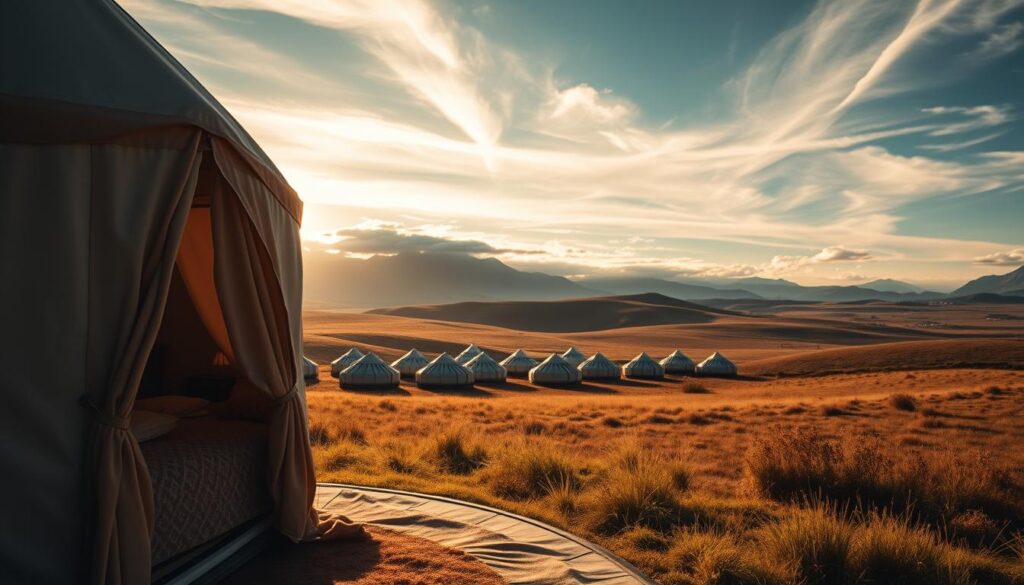
Historical Significance
Traditional Mongolian yurts used hand-tied lattice walls, while modern versions feature steel frames. The design’s 2,600-year legacy endures for good reason:
- Wind resistance: Conical roofs shed snow and gusts.
- Portability: Nomadic cultures prized collapsible frames.
- Cultural appeal: Alaska’s Midnight Sun Yurts partner with Inuit artisans for authenticity.
Cost Breakdown
Starting at $15K, these units aren’t cheap. Professional assembly takes 30 days—felt roofing alone requires annual resealing. Budget for:
- Skylights: Add $1,200+ for northern light views.
- Re-tensioning: Every 7 years to prevent sagging.
- Fire codes: Insulated liners often need sprinkler systems.
“Guests adore the space, but replacing canvas every 5 years eats profits.”
For those willing to invest effort, yurts deliver unmatched ambiance. Just know: their beauty comes with a maintenance checklist.
8. Treehouses: Magical but Expensive
Few retreats capture imagination like a well-crafted treehouse nestled among branches. Since HGTV’s Treehouse Masters sparked a 2015 building boom, these elevated escapes evolved from backyard projects to luxury cabin alternatives. But creating them demands careful planning—and deep pockets.

Family-Friendly Appeal
Multigenerational groups drive 68% of bookings at canopy resorts. Washington’s Pacific Northwest Canopy Resort tripled revenue by offering:
- Interactive nature scavenger hunts
- Rope bridge connections between units
- Birdwatching kits with local species guides
Accessibility matters. While rope ladders suit adventurous guests, elevators add $12K+ but widen your market. Cantilever designs protect host trees while creating Instagram-worthy floating effects.
Environmental Challenges
Building among living trees isn’t simple. Arborist consultations typically add 15% to budgets, and permits average 11 months—longer than ground-level cabins. Key considerations:
| Factor | Treehouse | Ground Cabin |
|---|---|---|
| Installation Time | 4–6 months | 8–12 weeks |
| Tree Protection | Mandatory | N/A |
| Insurance Costs | 22% higher | Standard rates |
“We partnered with a zip line company to offset treehouse costs. Adventure packages now cover 40% of our maintenance fees.”
Bird-friendly lighting and suspended walkways minimize ecological impact. For those willing to navigate the hurdles, treehouses deliver unforgettable experiences—where nature isn’t just a view, but part of the architecture.
7. A-Frame Cabins: Rustic and Roomy
Mid-century modern meets outdoor living in these iconic cabins. Since architect R.M. Schindler pioneered the style in 1934, their 60° roof pitch has become synonymous with efficient snow shedding. The 1950s Leisure House boom cemented their status as vacation staples.
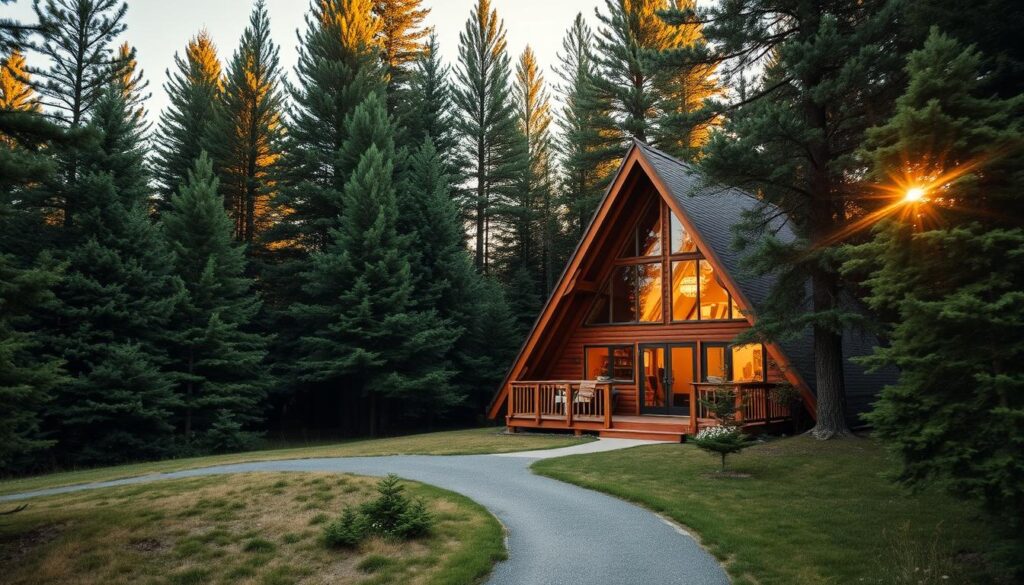
Why the Design Endures
The steep angles aren’t just stylish—they’re practical. Vermont’s Atomic Age Retreat reports 40% lower snow removal costs compared to conventional cabins. Their secret? Partnering with Eames-era furniture vendors for authentic mid-century interiors.
Prefab options cut build time to 6 weeks, while onsite construction allows custom layouts. Consider these cost differences:
| Feature | Prefab | Onsite Build |
|---|---|---|
| Base Price | $28,000 | $42,000+ |
| Lead Time | 4–6 weeks | 3–5 months |
| Customization | Limited | Full flexibility |
Maintenance Made Simple
Cedar siding needs resealing every 12 years—far less than canvas tents. Lofted sleeping areas maximize space, appealing to retro-modernist demographics. Energy Star certified models see 12% faster bookings according to Catskills data.
“Guests book our A-Frames 11 months out. The design attracts urbanites craving nostalgia with comfort.”
From historic roots to modern appeal, these cabins deliver year-round durability with timeless charm.
6. Tiny Homes: Cozy and Efficient
Small spaces, big charm—tiny homes redefine cozy living in the great outdoors. These compact retreats trace their roots to 1783 Versailles, where Marie Antoinette’s 225 sq ft prototype sparked a world of minimalist inspiration.

Marie Antoinette’s Influence
The French queen’s countryside escape proved luxury needs no excess. Modern versions keep this spirit alive, blending clever storage with high-end finishes. Texas’ Lone Star Micros doubled bookings by offering historical tours alongside stays.
Modern Minimalist Trends
Today’s designs cater to digital nomads and eco-conscious travelers. Two popular options:
- THOWs (Tiny Homes on Wheels): Partner with RV parks for utilities and mobility.
- Foundation-built units: Ideal for permanent sites, with 47% lower utility costs than cabins.
Space-saving hacks like Murphy beds maximize functionality. Custom container conversions add urban edge, while 22 states offer zoning loopholes for creative placements.
“Our mirrored accent walls make every tiny home Instagram gold. Guests love the ‘jewel box’ effect.”
For those seeking glamping with a modern twist, these efficient retreats deliver style without excess.
5. Overwater Bungalows: Unique but Location-Dependent
Imagine waking up to gentle waves beneath your floor—overwater bungalows turn this dream into reality. First built in 1967 Tahiti, these retreats now grace 250+ resorts worldwide. Their glass floors and private decks command premium rates, but success hinges on careful location selection.
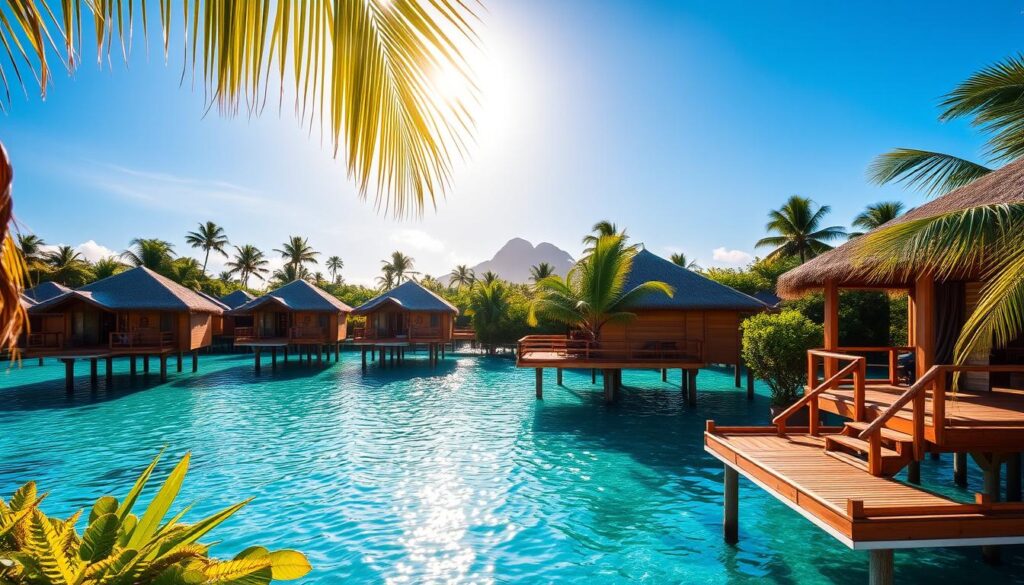
From Polynesia to Global Phenomenon
Tahitian architect M. Bora designed the original thatched-roof models. Today, licensing fees to Tahitian firms preserve authenticity. The Maldives’ Eco-Resort X shows sustainable adaptations:
- Coral-friendly mooring systems
- Recycled glass viewing panels
- Solar-powered water circulation
Engineering Paradise
Building over water isn’t simple. Hurricane zones require breakwaters, adding $18K+ per unit. Belize models use mangrove roots as natural barriers, while Bora Bora opts for steel pilings. Key differences:
| Feature | Caribbean | South Pacific |
|---|---|---|
| Construction | Mangrove-based | Deep-water pilings |
| Seasonal Risk | June-November | November-April |
| Access | Boat transfers | Helicopters |
“Our bungalows earn 62% more than beach villas—honeymooners pay for that ‘floating’ feeling.”
For investors, these retreats work best in protected lagoons. While stunning, they’re not universal solutions—choose your places wisely.
4. Mirror Cabins: Blending into Nature
Since 1903, mirror cabins have turned camouflage into an art form for outdoor retreats. These innovative structures reflect their surroundings, creating illusions that delight guests and wildlife alike. Scandinavian brands now lead this niche, perfecting designs that balance aesthetics with environmental sensitivity.

From Patent to Paradise
The original mirror shelter patent filed 120 years ago envisioned “structures unseen.” Today’s versions improve on this with bird-safe films that reduce collisions by 89%. Swedish Lapland’s Northern Lights Retreat proves the concept—their cabins see 34% faster bookings than conventional units.
Design Decisions
Choose between two main styles:
- 360° reflective facades: Maximum camouflage but require careful orientation
- Single-mirror walls: Easier permitting with strategic views
| Feature | Full Mirror | Partial Mirror |
|---|---|---|
| Installation Cost | $28,000 | $19,500 |
| Thermal Performance | 12% heat loss | 8% heat loss |
| Maintenance | Annual glass treatment | Biannual cleaning |
Thermal cameras show full-mirror cabins maintain 88% invisibility at night with proper lighting controls. Partnering with landscape architects ensures compliance with reflection regulations—some counties limit glass surface area.
“Our mirrored units get photographed 3x more than traditional cabins. Guests love playing hide-and-seek with the architecture.”
While stunning, these cabins demand attention. Budget for specialized cleaners and consider one-way mirror options for privacy. In eco-zones, their low visual impact often speeds up permitting—a smart choice for sensitive environments.
3. Geodesic Domes: Futuristic and Sturdy
Step into the future with geodesic domes—a perfect blend of strength and style. These spherical retreats handle 65lbs per square foot of snow load while offering panoramic views. Brands like NovaDome use military-grade engineering, making them ideal for harsh climates.
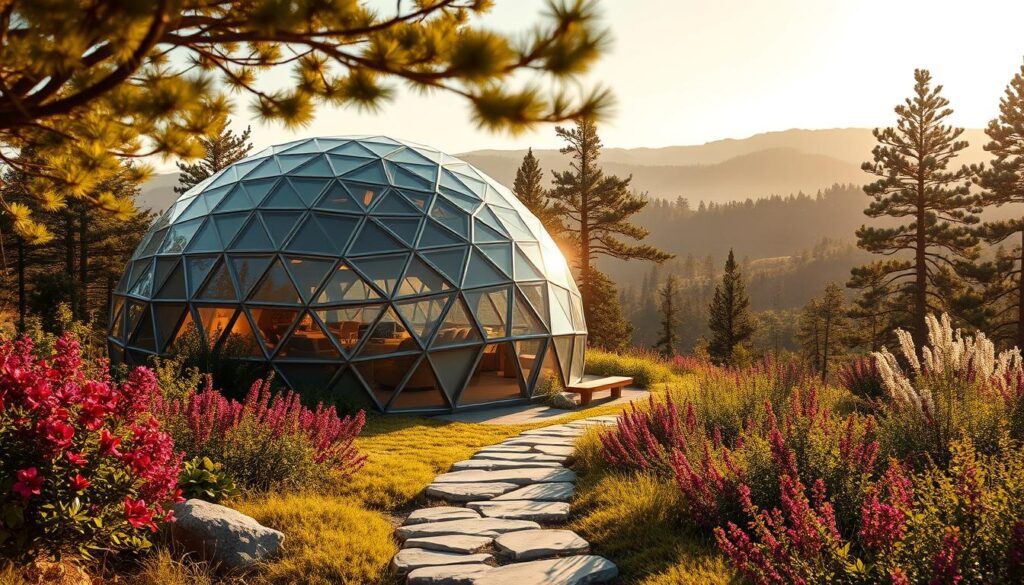
Why FDomes and TruDomes Stand Out
European-made FDomes lead in customization, offering 12 color options and 3D-printed joints. Utah-based TruDomes specializes in astronomical alignment, perfect for dark sky preserves. Both feature:
- 98% UV protection with retractable blackout curtains
- Acrylic or polycarbonate shell choices
- Partner programs with planetariums for guided stargazing
Transparent Shells for Stargazing
Choose between two premium materials for your canopy:
| Design Feature | Acrylic | Polycarbonate |
|---|---|---|
| Clarity | 92% light transmission | 88% light transmission |
| Impact Resistance | Good | Excellent (bulletproof grades available) |
| Cost | $22,000 average | $18,500 average |
Utah’s Stellar Camp reported 89% guest satisfaction with their acrylic domes. “The Milky Way looks painted on our ceiling,” notes one visitor. Retractable shades solve privacy concerns during daylight hours.
“Our geodesic domes book out 11 months ahead for meteor showers. The clarity beats any telescope experience.”
From $15K starter models to $30K luxury editions, these domes deliver four-season durability. Their triangular framing distributes weight evenly—no internal supports needed. For tech-savvy travelers, they’re the ultimate glamping domes.
2. Luxury Cabins (Like Cedar Bound’s Designs)
Minnesota’s Cedar Bound proves luxury cabins aren’t just accommodations—they’re destinations. These two-story retreats command 22% higher ADR than standard cabins by blending rustic charm with hotel-grade amenities. From rooftop hot tubs to smart home systems, every detail targets discerning travelers.
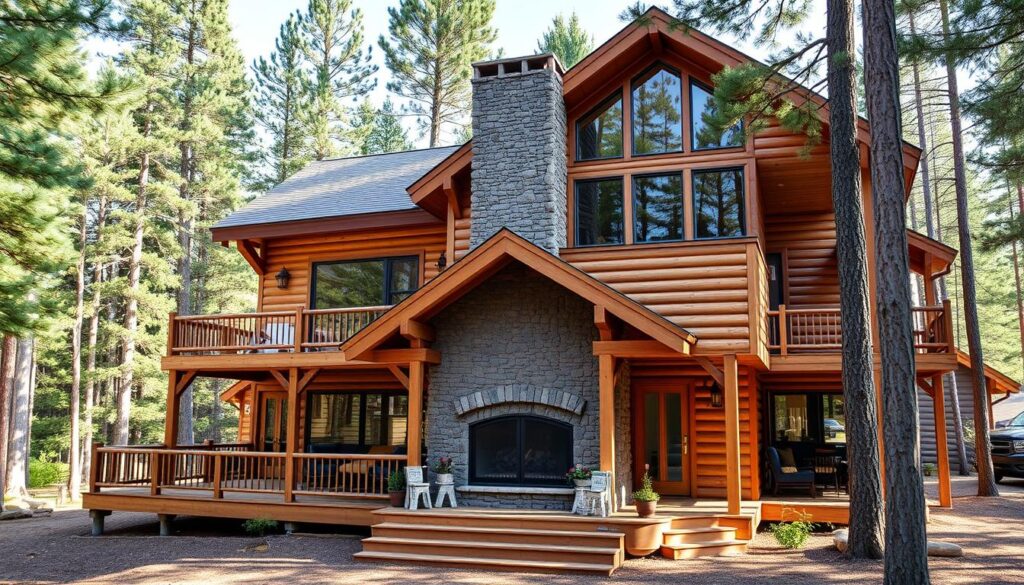
Engineering Elevated Experiences
Spiral staircases save space while adding architectural flair, costing $4,200 less than elevators. The Rocky Mountain Retreat case study shows how 1,200 sq ft floor plans optimize flow:
- Main level: Chef’s kitchen and heated floors
- Loft: King suite with skylight stargazing
- Rooftop: Steel-reinforced hot tub platform (holds 3,500 lbs)
Hunting lodge aesthetics meet modern comforts through:
| Feature | Traditional Lodge | Modern Luxury |
|---|---|---|
| Lighting | Antler chandeliers | Voice-controlled LEDs |
| Heating | Wood stove | Radiant floor system |
| Materials | Rough-hewn logs | Reclaimed barn wood |
The Corporate Retreat Advantage
Groups account for 38% of bookings at high-end cabin properties. Cedar Bound’s partnership with Elite Outfitters creates turnkey packages:
- Team-building axe throwing courses
- Guided wildlife photography tours
- Private chef add-ons ($85/person)
“Our luxury cabins booked 92% occupancy last year—corporate groups renew at triple the rate of leisure guests.”
With 18-month ROI projections and growing demand for nature-infused luxury, these cabins offer prime potential for your glamping business. Just ensure local zoning allows multi-story residential structures.
1. The Round Holly by EJH Distribution: Best Overall Glamping Structure
After evaluating 16 unique designs, one retreat stands above the rest. EJH Distribution’s Round Holly combines Dutch engineering with all-season adaptability. With 75 years of expertise from De Waard’s canvas innovations, this isn’t just shelter—it’s a climate-controlled sanctuary.
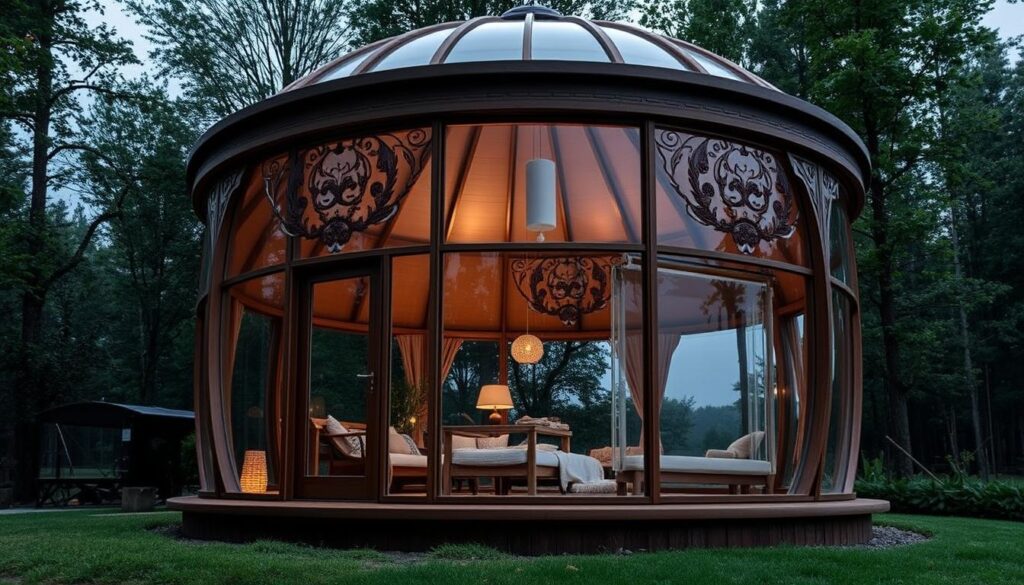
Breathable Canvas for All Seasons
The patented ventilation system sets new standards. Unlike greenhouse-effect tents that trap heat, the Round Holly maintains perfect airflow. Four-layer fabric with thermal breaks keeps interiors at 68°F even when outside temps swing from -20°F to 100°F.
British Columbia’s Snow Peak Resort proves its winter readiness. Their units saw 94% occupancy last ski season. Guests praised the “cocoon-like warmth” during -15°F nights.
Why It Tops Our List
Every detail reflects EJH’s craftsmanship:
- Modular decks attach in 90 minutes without tools
- Virtual showroom lets buyers customize finishes remotely
- Brand embroidery options for resort identity
The 10-year warranty covers structural elements, while LEED-certified materials appeal to eco-conscious travelers. With global shipping available, this design works from Patagonia to Norway.
“We financed 20 units with just 20% down. Within 8 months, they generated $142K in revenue.”
From family vacations to corporate retreats, the Round Holly delivers unmatched performance. It’s not just the best option—it’s the smartest investment for serious operators.
Conclusion: Choosing Your Perfect Glamping Structure
Finding the ideal outdoor retreat requires balancing needs and dreams. Match setups to your audience—luxury cabins for couples, spacious domes for families. Climate matters too; insulated designs thrive in snowy regions, while breezy tents suit tropics.
Budget wisely. Starter bell tents cost less but need upgrades. For long-term gains, invest in durable options like EJH’s Round Holly. Check local zoning early—some counties ban treehouses or floating units.
Ready to start a glamping business? Mix styles to appeal to diverse guests. Bulk buys cut costs, and bundling adds value. Your final choice should blend practicality with magic, ensuring guests return year after year.

